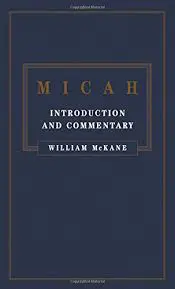

Micah: Introduction and Commentary
Pages
256 pages
Publisher
T&T Clark
Published
8/1/1998
ISBN-13
9780567086150
Collections
This book appears in the following featured collections.
- Favorite Advanced OT Commentaries by Jeremy Pierce (parableman)
Reviews
Edinburgh: T & T Clark, 1998. Pp. xiv + 242, Cloth, No Price Available, ISBN 0567086151. Jan A. Wagenaar Utrecht University Utrecht, The Netherlands The commentary by McKane is a classic example of a detailed textual and linguistic treatment of Old Testament texts. A fairly short introduction (pp.1-23) is followed by an extensive commentary on each chapter of the book (pp. 25-239). The introduction successively deals with the additions in the extant text, offers an outline of the book, states the premise of the author, sketches the redaction history and the Sitz im Lebenof the book and, finally, discusses the meaning of the messenger formula ko4h )amar yhwh 4 . The commentary meticulously deals with the Hebrew text and the variant readings found in LXX, Vulgate, Peshitta and Targum, discusses the interpretation of the Jewish mediaeval commentators Kimchi, Ibn Ezra and Rashi in detail and, last but not least, offers an evaluation of recent critical scholarship. The fullness of detail is certainly the greatest achievement of this commentary (even though in the end McKane seems to accept most of the traditional emendations to the text). The greatest strength of the commentary, however, is also its main weakness. The discussion of a difficult text more often than not gives way to a mere presentation of the various readings of the versions and the different interpretations of mediaeval and modern scholars. McKane's own assessment of the discussion can often be inferred from the translation offered at the end of the discussion, but it is not always presented as a clear-cut argument. A further weakness of a mainly textual and linguistic commentary comes to the fore when McKane's premise is held up against his discussion of mediaeval and modern scholarship. In the introduction McKane states that he has adopted as his point of departure the structure of the book, which has been outlined by B. Stade ("Bemerkungen über das Buch Micha", ZAW 1 [1881], 161-72; "Weitere Bemerkungen zu Micha 4.5", ZAW 3 [1883], 1-16; "Bemerkungen zu vorstehendem Aufsatze", ZAW 4 [1884], 291-97) in the 1880s and enriched by H. W. Wolff (Micha [BKAT XIV/4] Neukirchen-Vluyn 1982) almost a century later (pp. 7-8). In short: only Micah 1-3, with the exception of 2:12-13, can be assigned to the eighth century prophet Micah. The remainder of the book stems from prophets from subsequent centuries who enlarged the book of Micah both with prophecies of hope (chaps. 4-5) and prophecies of doom (6:1-7:7; 7:8-20 served as congregational responses and points to a public and liturgical use of the book).
[Full Review]
